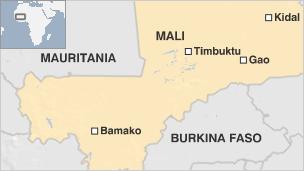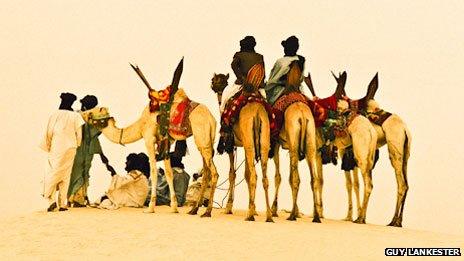Who, What, Why: Why do we know Timbuktu?
- Published

Rebels in Mali have taken the historic city of Timbuktu, a place that has become shorthand in English for anywhere far away. How did this metaphor come about?
"Omg! Just found out Timbuktu is a real place!"
The news that the city of Timbuktu has been seized by ethnic Tuaregs has had some tweeters scratching their heads, unaware up to now that it even existed.
While some people will be familiar with the Tuareg people, almost everyone will recognise the place name Timbuktu, even if they think it's mythical.
Once spelt as Timbuctoo, the city in northern Mali has come to represent a place far away, at the end of the world.
As the Oxford English Dictionary puts it, "the most distant place imaginable".
Its first documented use in this sense is dated to 1863, when the English writer Lady Duff-Gordon drew a contrast with the familiarity of Cairo.
In one of her Letters from Egypt, while in the Egyptian capital, she wrote:
It is growing dreadfully Cockney here. I must go to Timbuctoo.
Writers as diverse as DH Lawrence, Agatha Christie and Mr Men creator Roger Hargreaves further strengthened this association by references in their books.

In one of his final works, Nettles, in 1930, Lawrence wrote:
And the world it didn't give a hoot
If his blood was British or Timbuctoot.
Phrases that develop this idea include "from here to Timbuktu" when describing a very long journey, or "from Timbuktu to Kalamazoo" (a city in Michigan, US).
So why Timbuktu?
It was founded by Tuareg nomads in the 12th Century and within 200 years had become an immensely wealthy city, at the centre of important trading routes for salt and gold.
Through writers such as Leo Africanus, tales reached Europe of its immense riches, which stoked an acute curiosity on the part of European explorers.
This mystery was enhanced by its inaccessibility and many European expeditions perished, leaving it tantalisingly out of reach for centuries.
Before it was discovered by Europeans in 1830, all documented mentions of Timbuktu are about the efforts to get there, says OED revision editor Richard Shapiro.
"In 1820, people were talking about it taking 60 days from Tripoli and there were only six days without water.
"It was this legendary wealthy city, and the British hoped they could get from Africa the kind of riches Spain had got from South America."
In 1829, Alfred Tennyson described it as "mysterious" and "unfathomable" in his poem entitled Timbuctoo, and compared it to El Dorado and Atlantis.
It was not until 1830, long after the city had fallen into decline, that the first European went there and back again, Frenchman Rene Caillie.

"The Europeans came very late to Timbuktu," says Marie Rodet, lecturer at the School of Oriental and African Studies in London.
"For centuries, they tried to reach the place because it was a mythological place of trade and Islamic scholars.
"It had been described in Arab manuscripts in the Middle Ages so they knew about the history but they never reached it because the population never allowed them."
Locals regarded it as the holy city of 333 saints, she says, and Christians were the enemy, so Caillie went disguised as a Muslim. A Scot, Alexander Gordon Laing, beat him to it by four years but is thought to have been murdered before he could leave.
Even today, when the world has become a much smaller place, it remains relatively remote.
"You can get anywhere but Timbuktu is still very difficult to get to," says Richard Trillo, author of Rough Guide to West Africa. There is still no tarmac road to take travellers there.
The first time he went, he hitch-hiked from Hampshire in England in 1977, aged 21.
"We wanted to go to a place no-one else had been. Like many others, we had thought it a mythical place and when we realised it wasn't, it seemed like a good place for two guys to go on a gap year."
The journey was tough and took nearly six weeks, ending with a four-day boat trip on the River Niger and a truck ride supplied by a local police chief.
"Sub-Saharan Africa was so very different from the Arabic-speaking north. It felt like we had crossed an ocean, like we had skirted the edge of this huge continent. Timbuktu felt extraordinarily remote."
Trillo explains the endurance of the myth by the fact the city disappeared off the map when it fell into decline in the 17th and 18th Centuries, after the Moors deserted it and trade went elsewhere.
"For 200 years it was a city living on the sand but completely disconnected from the rest of the world and that was why it has such a mythology.
"Imagine New York suddenly under water for 200 years, and people still talking about it.
"That's when this explorer race started and everyone wanted to be the first to get to Timbuktu."
Reporting by Tom Geoghegan